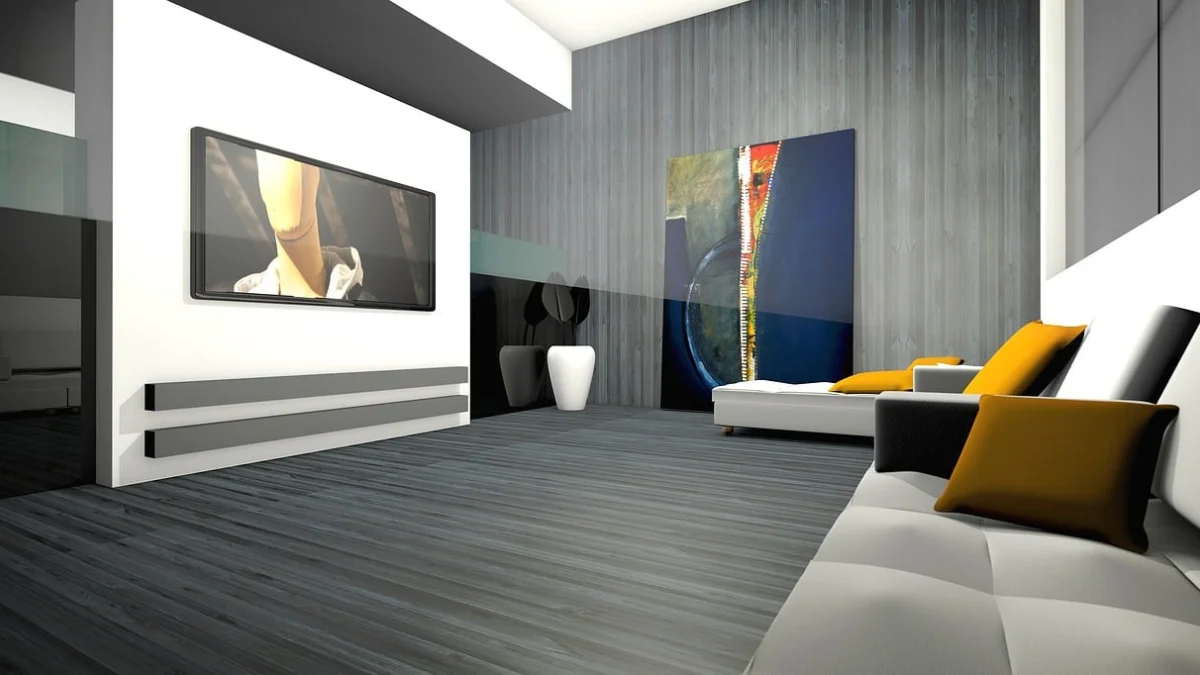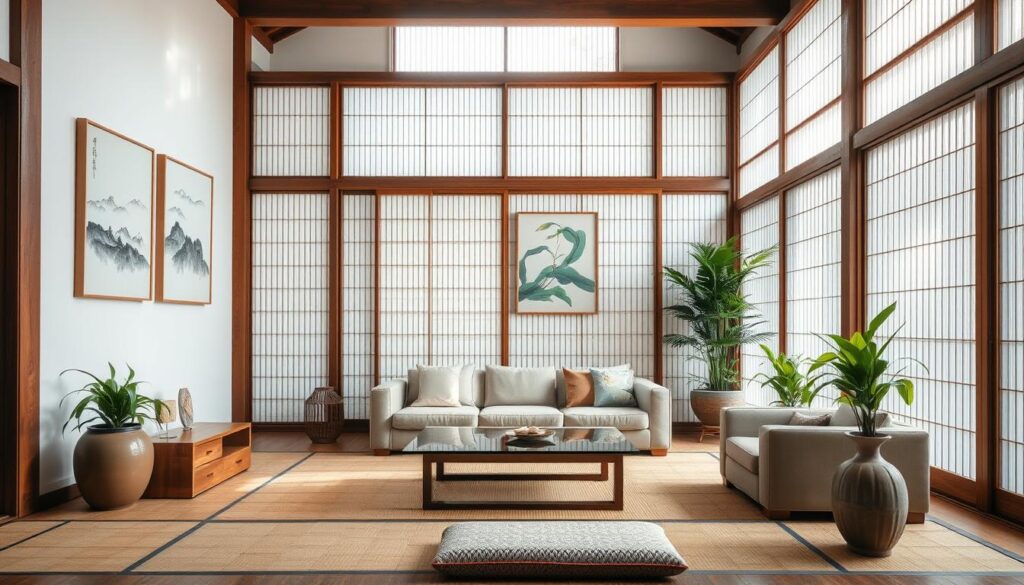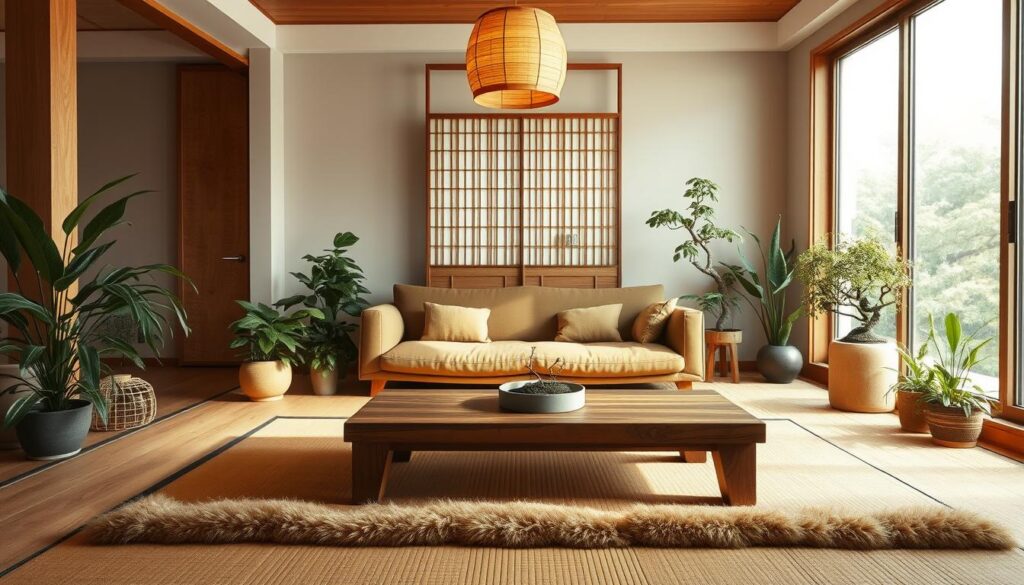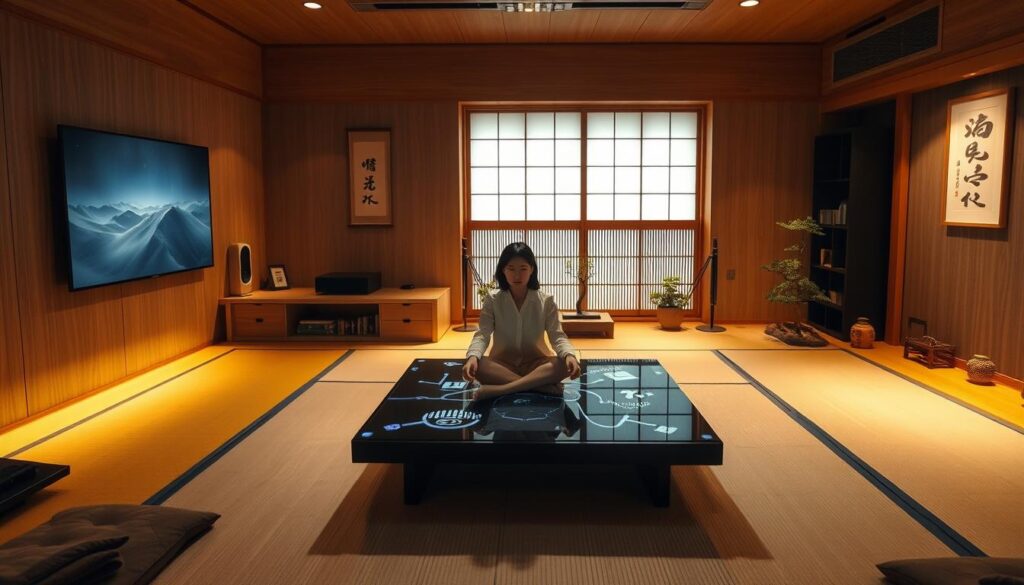
Thinking about updating your home in 2025? Look into Japanese living room trends. They mix natural elements, simple decor, and detail. This creates a peaceful and useful living area that shows off Japanese design.
In 2025, Japanese living room design will grow. It will focus on green materials, tech, and smart colors. Whether you want a calm spot or a lively area, Japanese trends have lots to inspire you. You can make a room that looks great and works well, showing off Japanese style.
Introduction to Japanese Living Room Trends
Exploring Japanese living room design, you’ll find many styles. From calm Zen rooms to lively, mixed spaces, Japanese design is unique. It helps you make a room that’s both lovely and useful, perfect for relaxing or having fun with family and friends.
Table of Contents
Key Takeaways
- Japanese living room trends focus on natural elements and simple decor.
- Modern Japanese design uses green materials and tech.
- Choosing colors and fabrics wisely makes a room harmonious and useful.
- Japanese design offers many styles for every taste.
- Using Japanese design principles, you can make a beautiful and practical space.
- Japanese trends are great for a quiet retreat or a lively party area.

Understanding Modern Japanese Living Room Design
Exploring japanese interior design reveals a mix of simplicity, naturalness, and function. The secret to a balanced space is blending traditional and modern elements. This mix makes japanese design stand out, appealing to those who love minimalist decor.
To design a living room inspired by japanese style, keep these tips in mind.
- Use natural materials like wood and bamboo for warmth and texture.
- Keep things simple with clean lines and minimal ornamentation for calmness.
- Value negative space to let the eye rest and enjoy the room’s beauty.
Following these principles helps you craft a living room that captures the spirit of japanese design and minimalist decor. Aim for a space that’s both useful and lovely, focusing on simplicity and natural elements.
Minimalist Zen Spaces: The Heart of Japanese Living Room Design
To make your living room peaceful, use natural elements. Bringing the outdoors in helps create a calm space. Think about adding plants, a water feature, or driftwood to relax your room.
A minimalist decor is crucial for a Zen space. It means removing clutter and focusing on simplicity. Choose simple colors and furniture with clean lines. This makes the room calm and balanced.
Some great natural elements for your space include:
- Reclaimed wood
- Bamboo
- Stone
- Plants
By mixing these elements with minimalist decor, you get a room that’s both lovely and useful. Keep it tidy and highlight the beauty of your chosen elements.
Natural Elements and Sustainable Materials
When designing a Japanese living room, it’s key to use natural elements and sustainable materials. Start by adding bamboo and wood, which bring warmth and texture. These can be used for floors, walls, or furniture, creating a calm and natural feel.
Choosing sustainable materials is also vital in Japanese design. Opt for eco-friendly options like recycled materials and low-VOC paints for a healthier space. Natural fibers like cotton or linen are great for upholstery and curtains. This way, your living room will be both stunning and eco-friendly.
Bamboo and Wood Integration
Bamboo and wood are favorites in Japanese design. Bamboo is renewable and versatile, perfect for floors and furniture. Wood adds warmth and texture, ideal for walls, floors, or ceilings.
Indoor Plants and Garden Views
Indoor plants and garden views bring calm and nature into your living room. Place plants like bonsai trees or orchids for harmony. Large windows or sliding doors can connect your room to a garden or outdoor space.

Eco-friendly Material Choices
Eco-friendly materials are crucial in Japanese design. Use recycled materials like reclaimed wood or glass for decor or furniture. Low-VOC paints and natural fibers like cotton or linen make your space healthier and sustainable. These choices make your living room beautiful and eco-friendly.
Technology Integration in Japanese Living Rooms
When designing a japanese living room, think about adding technology. This could be smart home devices, top-notch entertainment systems, or new ideas. Mixing technology with nature and a simple look makes the room modern yet calm.
Here are some tips to find the right mix:
- Use wireless charging stations to keep devices charged and hidden
- Install a sound system that fits well with the room’s design
- Add smart lighting that you can control from afar
Technology can also make your japanese living room more useful. For instance, a smart thermostat can adjust the temperature. Or, a high-tech coffee table with USB ports and wireless charging is handy.
By using technology wisely, you can make a japanese living room that looks great and works well. Just make sure to keep it simple and peaceful, following the principles of japanese design.
Color Palettes and Textures for Your Japanese Living Room
Designing your Japanese living room means picking the right colors and textures. These choices help make the room feel welcoming and peaceful. The right mix can make your space ideal for both relaxing and having fun.
Creating a Balance of Colors
For a balanced look, pick from many color palettes. You can go for traditional soft tones or modern bright colors. Think about using wood, bamboo, and plant colors, common in Japanese design. Adding silk and cotton textiles can also bring depth and texture.

Textile Choices and Patterns
Textiles are key in Japanese room design. They add warmth, comfort, and interest. Use traditional Japanese patterns like kanji or cherry blossoms for a unique feel. Mixing different textures, like woven baskets or throw blankets, can make the room cozy.
- Choose a dominant color palette and use it consistently throughout the room
- Select textile choices that complement the color palette and add texture to the space
- Consider using natural materials, such as wood and bamboo, to create a cohesive look
By picking the right colors and textiles, you can make a Japanese living room that’s both stunning and practical. It’s perfect for unwinding and enjoying time with friends and family.
Conclusion: Creating Your Perfect Japanese-Inspired Space
Creating your perfect Japanese living room is a journey of balance and harmony. Embrace simplicity, naturalism, and functionality to transform your space. Start by adding natural elements like bamboo, wood, and indoor plants.
Choose a calming color palette and tactile textures to enhance the peaceful ambiance. Make sure technology fits seamlessly into your design. With each choice, you’ll create a living room that reflects your style and nurtures your mind and spirit.
The journey to creating your Japanese-inspired living room is just as important as the end result. Trust your instincts and let your space evolve organically. The end result will be a serene oasis of elegance, your own personal retreat.
FAQ
What is the philosophy behind Japanese interior design?
Japanese interior design focuses on simplicity and naturalness. It aims for a balance between old and new. This creates a peaceful and harmonious space.
What are the key design principles to consider in a Japanese-inspired living room?
Key principles include using natural materials and keeping decor simple. It’s important to balance tradition with modern touches. This balance makes the space serene and inviting.
How can I incorporate natural elements and sustainable materials into my living room?
Add calm with bamboo, wood, and plants. Choose eco-friendly materials like recycled items and paints with low VOCs. These choices make your space sustainable and peaceful.
How can I balance technology integration with the principles of Japanese design?
Integrate tech in a way that fits with natural and simple design. Pick smart devices and entertainment that don’t clutter. This keeps your space calm and serene.
What color palettes and textures work best in a Japanese-inspired living room?
Traditional Japanese colors are soft and natural. Modern designs might use bolder colors and patterns. Silk and cotton textiles add depth and texture. Lighting and ambiance are key to setting the mood.
